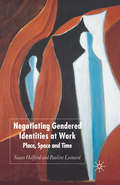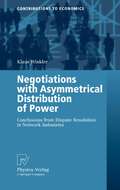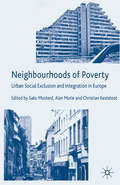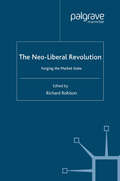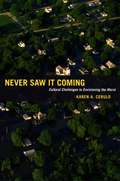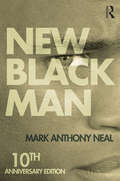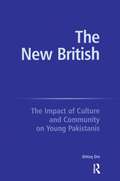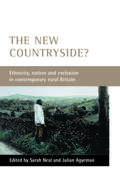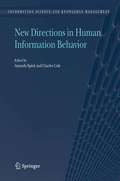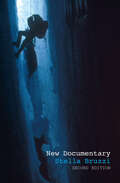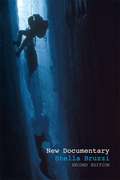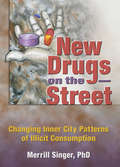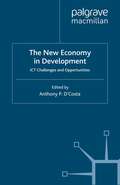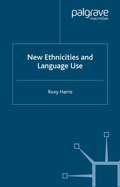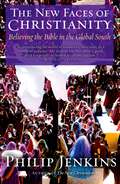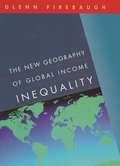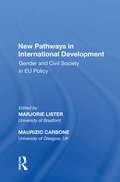- Table View
- List View
Negotiating Gendered Identities at Work: Place, Space and Time
by S. HalfordHow does gendered organizational life impact on individuals' identities in their everyday working lives? This question is explored with theoretical insights from disciplines including Sociology, Geography, History and Gender Studies interwoven with a major new empirical study of doctors and nurses working in the British National Health Service.
Negotiations with Asymmetrical Distribution of Power: Conclusions from Dispute Resolution in Network Industries (Contributions to Economics)
by Klaus WinklerNegotiations are of increasing importance in highly regulated sectors, particularly in network industries such as telecommunications and transport. Negotiating partners in these markets are often not equal with regard to their various sources and instruments of power. This analysis shows that negotiations are possible and can be efficient for all actors, even when power is distributed asymmetrically. Alternative Dispute Resolution (ADR) mechanisms are discussed as an alternative to conventional negotiations.
Neighbourhoods of Poverty: Urban Social Exclusion and Integration in Europe
by S. Musterd A. Murie C. KestelootNeighbourhoods of Poverty is concerned with the spatial dimension of urban social exclusion and integration. It draws on research from twenty-two neighbourhoods in eleven European cities: Amsterdam, Rotterdam, Brussels, Antwerp, London, Birmingham, Berlin, Hamburg, Milan, Naples and Paris and addresses two questions: - How do different neighbourhoods have an impact upon the opportunities and perspectives of poor individuals and households? - Are these neighbourhood impacts conditioned by national and welfare state contexts, by the wider metropolitan structures and by specific neighbourhood characteristics? Various aspects of poverty, social exclusion and integration are brought together and provide a new assessment of the place of neighbourhood within these wider debates.
The Neoliberal Revolution: Forging the Market State (International Political Economy Series)
by Richard RobisonThe book examines the rise of the amalgam of economic and political ideas we know as neo-liberalism and how these became the defining orthodoxy of our times. It investigates the inexorable global spread of market economies and how neo-liberal agendas are accommodated or hijacked in collisions with authoritarian states and populist oligarchies.
Never Saw It Coming: Cultural Challenges to Envisioning the Worst
by Karen A. CeruloPeople—especially Americans—are by and large optimists. They're much better at imagining best-case scenarios (I could win the lottery!) than worst-case scenarios (A hurricane could destroy my neighborhood!). This is true not just of their approach to imagining the future, but of their memories as well: people are better able to describe the best moments of their lives than they are the worst. Though there are psychological reasons for this phenomenon, Karen A.Cerulo, in Never Saw It Coming, considers instead the role of society in fostering this attitude. What kinds of communities develop this pattern of thought, which do not, and what does that say about human ability to evaluate possible outcomes of decisions and events? Cerulo takes readers to diverse realms of experience, including intimate family relationships, key transitions in our lives, the places we work and play, and the boardrooms of organizations and bureaucracies. Using interviews, surveys, artistic and fictional accounts, media reports, historical data, and official records, she illuminates one of the most common, yet least studied, of human traits—a blatant disregard for worst-case scenarios. Never Saw It Coming, therefore, will be crucial to anyone who wants to understand human attempts to picture or plan the future. “In Never Saw It Coming, Karen Cerulo argues that in American society there is a ‘positive symmetry,’ a tendency to focus on and exaggerate the best, the winner, the most optimistic outcome and outlook. Thus, the conceptions of the worst are underdeveloped and elided. Naturally, as she masterfully outlines, there are dramatic consequences to this characterological inability to imagine and prepare for the worst, as the failure to heed memos leading up to both the 9/11 and NASA Challenger disasters, for instance, so painfully reminded us.”--Robin Wagner-Pacifici, Swarthmore College “Katrina, 9/11, and the War in Iraq—all demonstrate the costliness of failing to anticipate worst-case scenarios. Never Saw It Coming explains why it is so hard to do so: adaptive behavior hard-wired into human cognition is complemented and reinforced by cultural practices, which are in turn institutionalized in the rules and structures of formal organizations. But Karen Cerulo doesn’t just diagnose the problem; she uses case studies of settings in which people effectively anticipate and deal with potential disaster to describe structural solutions to the chronic dilemmas she describes so well. Never Saw It Coming is a powerful contribution to the emerging fields of cognitive and moral sociology.”--Paul DiMaggio, Princeton University
Never Saw It Coming: Cultural Challenges to Envisioning the Worst
by Karen A. CeruloPeople—especially Americans—are by and large optimists. They're much better at imagining best-case scenarios (I could win the lottery!) than worst-case scenarios (A hurricane could destroy my neighborhood!). This is true not just of their approach to imagining the future, but of their memories as well: people are better able to describe the best moments of their lives than they are the worst. Though there are psychological reasons for this phenomenon, Karen A.Cerulo, in Never Saw It Coming, considers instead the role of society in fostering this attitude. What kinds of communities develop this pattern of thought, which do not, and what does that say about human ability to evaluate possible outcomes of decisions and events? Cerulo takes readers to diverse realms of experience, including intimate family relationships, key transitions in our lives, the places we work and play, and the boardrooms of organizations and bureaucracies. Using interviews, surveys, artistic and fictional accounts, media reports, historical data, and official records, she illuminates one of the most common, yet least studied, of human traits—a blatant disregard for worst-case scenarios. Never Saw It Coming, therefore, will be crucial to anyone who wants to understand human attempts to picture or plan the future. “In Never Saw It Coming, Karen Cerulo argues that in American society there is a ‘positive symmetry,’ a tendency to focus on and exaggerate the best, the winner, the most optimistic outcome and outlook. Thus, the conceptions of the worst are underdeveloped and elided. Naturally, as she masterfully outlines, there are dramatic consequences to this characterological inability to imagine and prepare for the worst, as the failure to heed memos leading up to both the 9/11 and NASA Challenger disasters, for instance, so painfully reminded us.”--Robin Wagner-Pacifici, Swarthmore College “Katrina, 9/11, and the War in Iraq—all demonstrate the costliness of failing to anticipate worst-case scenarios. Never Saw It Coming explains why it is so hard to do so: adaptive behavior hard-wired into human cognition is complemented and reinforced by cultural practices, which are in turn institutionalized in the rules and structures of formal organizations. But Karen Cerulo doesn’t just diagnose the problem; she uses case studies of settings in which people effectively anticipate and deal with potential disaster to describe structural solutions to the chronic dilemmas she describes so well. Never Saw It Coming is a powerful contribution to the emerging fields of cognitive and moral sociology.”--Paul DiMaggio, Princeton University
Never Saw It Coming: Cultural Challenges to Envisioning the Worst
by Karen A. CeruloPeople—especially Americans—are by and large optimists. They're much better at imagining best-case scenarios (I could win the lottery!) than worst-case scenarios (A hurricane could destroy my neighborhood!). This is true not just of their approach to imagining the future, but of their memories as well: people are better able to describe the best moments of their lives than they are the worst. Though there are psychological reasons for this phenomenon, Karen A.Cerulo, in Never Saw It Coming, considers instead the role of society in fostering this attitude. What kinds of communities develop this pattern of thought, which do not, and what does that say about human ability to evaluate possible outcomes of decisions and events? Cerulo takes readers to diverse realms of experience, including intimate family relationships, key transitions in our lives, the places we work and play, and the boardrooms of organizations and bureaucracies. Using interviews, surveys, artistic and fictional accounts, media reports, historical data, and official records, she illuminates one of the most common, yet least studied, of human traits—a blatant disregard for worst-case scenarios. Never Saw It Coming, therefore, will be crucial to anyone who wants to understand human attempts to picture or plan the future. “In Never Saw It Coming, Karen Cerulo argues that in American society there is a ‘positive symmetry,’ a tendency to focus on and exaggerate the best, the winner, the most optimistic outcome and outlook. Thus, the conceptions of the worst are underdeveloped and elided. Naturally, as she masterfully outlines, there are dramatic consequences to this characterological inability to imagine and prepare for the worst, as the failure to heed memos leading up to both the 9/11 and NASA Challenger disasters, for instance, so painfully reminded us.”--Robin Wagner-Pacifici, Swarthmore College “Katrina, 9/11, and the War in Iraq—all demonstrate the costliness of failing to anticipate worst-case scenarios. Never Saw It Coming explains why it is so hard to do so: adaptive behavior hard-wired into human cognition is complemented and reinforced by cultural practices, which are in turn institutionalized in the rules and structures of formal organizations. But Karen Cerulo doesn’t just diagnose the problem; she uses case studies of settings in which people effectively anticipate and deal with potential disaster to describe structural solutions to the chronic dilemmas she describes so well. Never Saw It Coming is a powerful contribution to the emerging fields of cognitive and moral sociology.”--Paul DiMaggio, Princeton University
New Black Man: Tenth Anniversary Edition
by Mark Anthony NealTen years ago, Mark Anthony Neal’s New Black Man put forth a revolutionary model of Black masculinity for the twenty-first century—one that moved beyond patriarchy to embrace feminism and combat homophobia. Now, Neal’s book is more vital than ever, urging us to imagine a New Black Man whose strength resides in family, community, and diversity. Part memoir, part manifesto, this book celebrates the Black man of our times in all his vibrancy and virility. The tenth anniversary edition of this classic text includes a new foreword by Joan Morgan and a new introduction and postscript from Neal, which bring the issues in the book up to the present day.
New Black Man: Tenth Anniversary Edition
by Mark Anthony NealTen years ago, Mark Anthony Neal’s New Black Man put forth a revolutionary model of Black masculinity for the twenty-first century—one that moved beyond patriarchy to embrace feminism and combat homophobia. Now, Neal’s book is more vital than ever, urging us to imagine a New Black Man whose strength resides in family, community, and diversity. Part memoir, part manifesto, this book celebrates the Black man of our times in all his vibrancy and virility. The tenth anniversary edition of this classic text includes a new foreword by Joan Morgan and a new introduction and postscript from Neal, which bring the issues in the book up to the present day.
The New British: The Impact of Culture and Community on Young Pakistanis
by Ikhlaq DinProviding empirical evidence on the lives of young British-born Pakistanis, The New British also reveals fascinating insights into the Pakistani community more generally. Using Bradford as a case study, Ikhlaq Din focuses on the relationship between young boys and girls, their parents, and the Pakistani community. He discusses various issues that are important to young people, such as: their experience of school; their aspirations; their identity; their attitude to community; their relationships with parents; the tensions between Islam and popular culture and the role Islam plays in the wider Pakistani community. The impact of broader national and international events such as 9/11 and 7/7 on the lives of young British-born Pakistanis is also considered.
The New British: The Impact of Culture and Community on Young Pakistanis
by Ikhlaq DinProviding empirical evidence on the lives of young British-born Pakistanis, The New British also reveals fascinating insights into the Pakistani community more generally. Using Bradford as a case study, Ikhlaq Din focuses on the relationship between young boys and girls, their parents, and the Pakistani community. He discusses various issues that are important to young people, such as: their experience of school; their aspirations; their identity; their attitude to community; their relationships with parents; the tensions between Islam and popular culture and the role Islam plays in the wider Pakistani community. The impact of broader national and international events such as 9/11 and 7/7 on the lives of young British-born Pakistanis is also considered.
The new countryside?: Ethnicity, nation and exclusion in contemporary rural Britain
by Sarah Neal Julian AgyemanThis book explores issues of ethnicity, identity and racialised exclusion in rural Britain, in depth and for the first time. It questions what the countryside 'is', problematises who is seen as belonging to rural spaces, and argues for the recognition of a rural multiculture. The book brings together the latest and most extensive research findings to provide an authoritative account of current theory, policy and practice. Using interdisciplinary frameworks and new empirical data, the book provides a critical and comprehensive account of the shifting, contested connections between rurality, national identity and ethnicity; discusses the relationships between ethnicity, exclusion, policy, practice and research in a range of rural settings - from the experiences of gypsy traveller children in schools to attempts to encourage black and minority ethnic visitors to National Parks and contributes towards establishing the 'rural-ethnicity-nation' relationship as a key consideration on political and policy agendas. The new countryside? is essential reading for students, academics and researchers in a wide range of disciplines including: sociology; geography; social policy; and cultural, rural and environment studies. It will also be an invaluable resource for practitioners and policy makers across a wide range of sectors and services.
New Directions in Human Information Behavior (Information Science and Knowledge Management #8)
by Amanda Spink Charles ColeNew Directions in Human Information Behavior, co-edited by Drs. Amanda Spink and Charles Cole provides an understanding of the new directions, leading edge theories and models in human information behavior. Information behavior is conceptualized as complex human information related processes that are embedded within an individual’s everyday social and life processes. The book presents chapters by an interdisciplinary range of scholars who show new directions that often challenge the established views and paradigms of information behavior studies. Beginning with an evolutionary framework, the book examines information behaviors over various epochs of human existence from the Palaeolithic Era and within pre-literate societies, to contemporary behaviors by 21st century humans. Drawing upon social and psychological science theories the book presents a more integrated and holistic approach to the understanding of information behaviors that include multitasking and non-linear longitudinal processes, individuals’ information ground, information practices and information sharing, digital behaviors and human information organizing behaviors. The final chapter of the book integrates these new approaches and presents an overview of the key trends, theories and models for further research. This book is directly relevant to information scientists, librarians, social and evolutionary psychologists. Undergraduate and graduate students, academics and information professionals interested in human information behavior will find this book of particular benefit.
New Documentary
by Stella BruzziPraise for New Documentary: 'It's refreshing to find a book that cuts through the tired old debates that have surrounded documentary film and television. It heralds a welcome new approach.' Sight and Sound 'Documentary practice changes so fast that books on the subject are often out of date before they are published. Bruzzi's achievement is to have understood the genre as an activity based on performance rather than observation. This is a fresh perspective which illuminates the fundamental shifts that will continue to take place in the genre as it enters its second century.' John Ellis, Professor of Media Arts, Royal Holloway, University of LondonNew Documentary provides a contemporary look at documentary and fresh and challenging ways of theorising the non-fiction film. As engaging as the original, this second edition features thorough updates to the existing chapters, as well as a brand new chapter on contemporary cinema release documentaries. This new edition includes: Contemporary films such as Capturing the Friedmans, Être et avoir, Farenheit 9/11, The Fog of War and Touching the Void as well as more canonical texts such as Hoop Dreams and Shoah Additional interviews with influential practitioners, such as director Michael Apted and producer Stephen Lambert A comprehensively revised discussion of modern observational documentary, including docusoaps, reality television and formatted documentaries The work of documentary filmmakers such as Nicholas Barker, Errol Morris, Nick Broomfield, Molly Dineen and Michael Moore and the work of Avant-Garde filmmakers such as Chris Marker and Patrick Keiller Gender identity, queer theory, performance, race and spectatorship. Bruzzi shows how theories of documentary filmmaking can be applied to contemporary texts and genres, and discusses the relationship between recent, innovative examples of the genre and the more established canon of documentary.
New Documentary
by Stella BruzziPraise for New Documentary: 'It's refreshing to find a book that cuts through the tired old debates that have surrounded documentary film and television. It heralds a welcome new approach.' Sight and Sound 'Documentary practice changes so fast that books on the subject are often out of date before they are published. Bruzzi's achievement is to have understood the genre as an activity based on performance rather than observation. This is a fresh perspective which illuminates the fundamental shifts that will continue to take place in the genre as it enters its second century.' John Ellis, Professor of Media Arts, Royal Holloway, University of LondonNew Documentary provides a contemporary look at documentary and fresh and challenging ways of theorising the non-fiction film. As engaging as the original, this second edition features thorough updates to the existing chapters, as well as a brand new chapter on contemporary cinema release documentaries. This new edition includes: Contemporary films such as Capturing the Friedmans, Être et avoir, Farenheit 9/11, The Fog of War and Touching the Void as well as more canonical texts such as Hoop Dreams and Shoah Additional interviews with influential practitioners, such as director Michael Apted and producer Stephen Lambert A comprehensively revised discussion of modern observational documentary, including docusoaps, reality television and formatted documentaries The work of documentary filmmakers such as Nicholas Barker, Errol Morris, Nick Broomfield, Molly Dineen and Michael Moore and the work of Avant-Garde filmmakers such as Chris Marker and Patrick Keiller Gender identity, queer theory, performance, race and spectatorship. Bruzzi shows how theories of documentary filmmaking can be applied to contemporary texts and genres, and discusses the relationship between recent, innovative examples of the genre and the more established canon of documentary.
New Drugs on the Street: Changing Inner City Patterns of Illicit Consumption
by Merrill SingerLearn the public health implications of shifting drug-related risks among the inner city poorInner city drug use behavior shifts and changes, leaving past drug treatment programs, drug prevention efforts, health care provisions for drug users, and social service practice unprepared to effectively respond. New Drugs on the Street: Changing Inner City Patterns of Illicit Consumption tackles this problem by presenting the latest ethnographic and epidemiological studies of emerging and changing drug use behaviors in the inner city. This one-of-a-kind resource provides the latest research to help readers reconceptualize ways to think about today&’s drug use to more effectively address the growing problem.Unless public health and social service professionals keep in step with the shifting patterns of drug behaviors, drug use epidemics will inevitably unfold. New Drugs on the Street reveals the latest drug use practices of the poor in the inner city, with a concentration on the research in African-American and Latino populations. Each chapter gives an in-depth look at the use of various psychotropic drugs most recently gaining popularity, along with the surprising reemergence of PCP. The rampant use of ecstasy in the rave scene is explored, along with the effects of its heavy use, its after-effects, the likelihood of poly-drug mixing, and dangerous sex risk behaviors. Urban youth drug networking is examined in detail. The alarming use of embalming fluid mixtures is discussed, along with the disturbing public health implications of its use. The illicit use of narcotics analgesics (NA) like Vicodin and other pain killers is also explored, including the unclear association between NA use and Hepatitis C. A final chapter presents the latest information on Haitian youth and young adults in Miami, Florida, with ethnographic background to illustrate the reasons for drug use in this and other ethnic minorities. This valuable source is extensively referenced and includes several helpful tables to clarify research data.New Drugs on the Street examines: ecstasy diverted pharmaceutical painkillers PCP embalming fluid narcotics analgesics (NA) drug use dynamics the changing street drug scene new drug combinations new drug-involved populationsNew Drugs on the Street reveals the nature and direction of the latest drug use and is essential reading for health professionals in the health social sciences, public health, nursing, and substance abuse fields that deal with low income, ethnic minority, and inner city populations.
New Drugs on the Street: Changing Inner City Patterns of Illicit Consumption
by Merrill SingerLearn the public health implications of shifting drug-related risks among the inner city poorInner city drug use behavior shifts and changes, leaving past drug treatment programs, drug prevention efforts, health care provisions for drug users, and social service practice unprepared to effectively respond. New Drugs on the Street: Changing Inner City Patterns of Illicit Consumption tackles this problem by presenting the latest ethnographic and epidemiological studies of emerging and changing drug use behaviors in the inner city. This one-of-a-kind resource provides the latest research to help readers reconceptualize ways to think about today&’s drug use to more effectively address the growing problem.Unless public health and social service professionals keep in step with the shifting patterns of drug behaviors, drug use epidemics will inevitably unfold. New Drugs on the Street reveals the latest drug use practices of the poor in the inner city, with a concentration on the research in African-American and Latino populations. Each chapter gives an in-depth look at the use of various psychotropic drugs most recently gaining popularity, along with the surprising reemergence of PCP. The rampant use of ecstasy in the rave scene is explored, along with the effects of its heavy use, its after-effects, the likelihood of poly-drug mixing, and dangerous sex risk behaviors. Urban youth drug networking is examined in detail. The alarming use of embalming fluid mixtures is discussed, along with the disturbing public health implications of its use. The illicit use of narcotics analgesics (NA) like Vicodin and other pain killers is also explored, including the unclear association between NA use and Hepatitis C. A final chapter presents the latest information on Haitian youth and young adults in Miami, Florida, with ethnographic background to illustrate the reasons for drug use in this and other ethnic minorities. This valuable source is extensively referenced and includes several helpful tables to clarify research data.New Drugs on the Street examines: ecstasy diverted pharmaceutical painkillers PCP embalming fluid narcotics analgesics (NA) drug use dynamics the changing street drug scene new drug combinations new drug-involved populationsNew Drugs on the Street reveals the nature and direction of the latest drug use and is essential reading for health professionals in the health social sciences, public health, nursing, and substance abuse fields that deal with low income, ethnic minority, and inner city populations.
The New Economy in Development: ICT Challenges and Opportunities (Technology, Globalization and Development)
by A. D'CostaThe New Economy in Development presents conceptual and empirical analyses of the opportunities offered by information and communications technologies (ICT). Contributors include scholars and policy makers from international organizations, and the chapters include understudied cases from Africa, Latin America, Eastern Europe and Asia.
New Ethnicities and Language Use (Language and Globalization)
by R. HarrisThe children and grandchildren of South Asian migrants to the UK are living out British identities which go largely unrecognized. This book emphasizes their everyday low-key Britishness, albeit a Britishness with new inflections. It is this sensibility that marks them as Brasians .
The New Faces of Christianity: Believing the Bible in the Global South
by Philip JenkinsNamed one of the top religion books of 2002 by USA Today, Philip Jenkins's phenomenally successful The Next Christendom permanently changed the way people think about the future of Christianity. In that volume, Jenkins called the world's attention to the little noticed fact that Christianity's center of gravity was moving inexorably southward, to the point that Africa may soon be home to the world's largest Christian populations. Now, in this brilliant sequel, Jenkins takes a much closer look at Christianity in the global South, revealing what it is like, and what it means for the future. The faith of the South, Jenkins finds, is first and foremost a biblical faith. Indeed, in the global South, many Christians identify powerfully with the world portrayed in the New Testament--an agricultural world very much like their own, marked by famine and plague, poverty and exile, until very recently a society of peasants, farmers, and small craftsmen. In the global South, as in the biblical world, belief in spirits and witchcraft are commonplace, and in many places--such as Nigeria, Indonesia, and Sudan--Christians are persecuted just as early Christians were. Thus the Bible speaks to the global South with a vividness and authenticity simply unavailable to most believers in the industrialized North. More important, Jenkins shows that throughout the global South, believers are reading the Bible with fresh eyes, and coming away with new and sometimes startling interpretations. Some of their conclusions are distinctly fundamentalist, but Jenkins finds an intriguing paradox, for they are also finding ideas in the Bible that are socially liberating, especially with respect to women's rights. Across Africa, Asia, and Latin America, such Christians are social activists in the forefront of a wide range of liberation movements. It's hard to overstate how interesting, how eye-opening, how frequently surprising (and sometimes disturbing) Jenkins' findings are. Anyone interested in the implications of these trends for the major denominations, for Muslim-Christian conflict, and for global politics will find The New Faces of Christianity provocative and incisive--and indispensable.
The New Geography of Global Income Inequality
by Glenn FirebaughThe surprising finding of this book is that, contrary to conventional wisdom, global income inequality is decreasing. Critics of globalization and others maintain that the spread of consumer capitalism is dramatically polarizing the worldwide distribution of income. But as the demographer Glenn Firebaugh carefully shows, income inequality for the world peaked in the late twentieth century and is now heading downward because of declining income inequality across nations. Furthermore, as income inequality declines across nations, it is rising within nations (though not as rapidly as it is declining across nations). Firebaugh claims that this historic transition represents a new geography of global income inequality in the twenty-first century. This book documents the new geography, describes its causes, and explains why other analysts have missed one of the defining features of our era—a transition in inequality that is reducing the importance of where a person is born in determining his or her future well-being.
The New NHS: A Guide
by Alison Talbot-Smith Allyson M. PollockDr Alison Talbot-Smith, an experienced doctor and researcher, and Professor Allyson M. Pollock, one of the UKs leading authorities on the NHS, give a lucid and incisive account of the new NHS – which has emerged from a far-reaching programme of market-oriented changes. Providing an authoritative and accessible overview of the new NHS, the book describes: the structures and functions of the new organizations in each of the devolved countries the funding of NHS services, education, training and research and resource allocation the regulation of the new NHS systems and workforce the relationships between the NHS, the Department of Health, local authorities and regulatory bodies, and between the NHS and the private sector the future implications of current policies. This is an indispensable resource for those working in healthcare today as clinicians, academics, researchers and managers. It will also be essential reading for academics, students, and researchers in related fields, as well as the general public.
The New NHS: A Guide
by Alison Talbot-Smith Allyson M. PollockDr Alison Talbot-Smith, an experienced doctor and researcher, and Professor Allyson M. Pollock, one of the UKs leading authorities on the NHS, give a lucid and incisive account of the new NHS – which has emerged from a far-reaching programme of market-oriented changes. Providing an authoritative and accessible overview of the new NHS, the book describes: the structures and functions of the new organizations in each of the devolved countries the funding of NHS services, education, training and research and resource allocation the regulation of the new NHS systems and workforce the relationships between the NHS, the Department of Health, local authorities and regulatory bodies, and between the NHS and the private sector the future implications of current policies. This is an indispensable resource for those working in healthcare today as clinicians, academics, researchers and managers. It will also be essential reading for academics, students, and researchers in related fields, as well as the general public.
New Pathways in International Development: Gender and Civil Society in EU Policy
by Maurizio Carbone Marjorie ListerGender considerations and civil society are both major issues in the current debate about the implementation of EU development policy. This volume provides a new perspective and focus on the increasingly important issues of gender equality, democracy and participation to explain how they impact on policy. This book will appeal to those interested in the European Union, in EU external relations, gender issues, civil society, and development.
New Pathways in International Development: Gender and Civil Society in EU Policy
by Maurizio Carbone Marjorie ListerGender considerations and civil society are both major issues in the current debate about the implementation of EU development policy. This volume provides a new perspective and focus on the increasingly important issues of gender equality, democracy and participation to explain how they impact on policy. This book will appeal to those interested in the European Union, in EU external relations, gender issues, civil society, and development.
